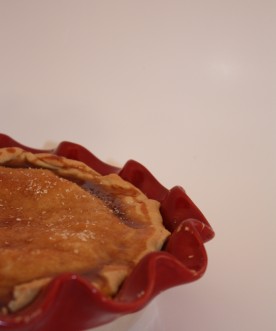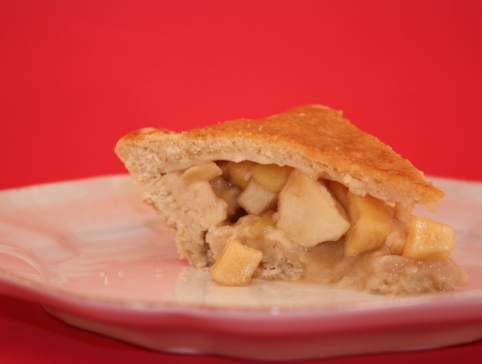The April 2010 Daring Bakers’ challenge was hosted by Esther of The Lilac Kitchen. She challenged everyone to make a traditional British pudding using, if possible, a very traditional British ingredient: suet.
I love being part of the Daring Bakers because I always learn something from the challenge and there are a lot of time it pushes me outside my comfort zone when it comes to cooking and trying new things in the kitchen. This month was no exception, I was really excited when I read about this months challenge and what it entailed, not only were we challenged to work with an ingredient that is not common in the states but we were also challenged to make a dish that is not common here. We were challenged to use suet to make a British pudding dish which could be either savory or sweet. The options were endless as far as the combinations and varieties of puddings that could be made, and there were multiple ways this dish could be cooked. I really enjoyed this challenge but I was kind of disappointed because I wasn’t able to find any suet so I used Crisco, which was one of the alternative ingredients that was suggested in case suet wasn’t available. Not being able to find the suet was the only problem I ran into; everything else went well and I was really happy with the outcome. I made a sweet pudding this time, but I’m still going to be on the look out for suet and once I come across some I want to make a savory pudding. The toffee apple pudding I made this time was great; the apple filling was so delicious and the crust had a great flavor!
Some of you reading this are probably wondering what suet is, so before I go any further I will share a brief description.
Suet (/ˈsuː.ɪt/) is raw beef or mutton fat, especially the hard fat found around the loins and kidneys.
The primary use of suet is to make tallow, although it is also used as an ingredient in cooking, especially in traditional puddings, such as English Christmas Pudding. Suet is made into tallow in a process called rendering, which involves melting and extended simmering, followed by straining, cooling and usually a repetition of the entire process.
Unlike tallow, suet that is not pre-packed requires refrigeration in order to be stored for extended periods.
Suet is essential in traditional English steamed puddings, and in the pastry for steak and kidney pudding, in which a pudding bowl is lined with the suet crust pastry, the meat added and a lid of suet crust tightly seals the meat. The pudding is then steamed for approximately four hours before serving in the bowl on the table. Suet pastry is soft in contrast to the crispness of shortcrust pastry.
Suet is also an ingredient of traditional mincemeat (fruit mince).
Suet should not be confused with beef dripping, which is the collected fat and juices from the roasting pan when cooking roast beef and is not rendered.
Due to its high calorific content, suet is used by cold weather explorers to supplement the high daily energy requirement needed to travel in such climates. Typically the calorie requirement is in the region of 5,000-6,000 KCals per day for sledge hauling or dog-sled travelling. Suet is added to food rations to increase the fat content and help meet this high calorie requirement.
Information take from: Wikipedia
Now, on to the challenge!
Toffee Apple Pudding
Ingredients:
180 Grams self-rising flour
Pinch of sugar
1/2 Teaspoon cinnamon
90 Grams shredded suet (I used Crisco since I couldn’t find suet)
Cold Water to mix (I did half water, half milk for a richer crust)
4 Cooking apples; peeled, cored and sliced
1 Tablespoon lemon juice
120 Grams dermerara sugar
1 Tablespoon golden syrup
Directions:
Preheat oven to 350 F.
Sift the cinnamon, sugar and flour together and then mix in the suet. Add water, 1 tablespoon at a time until a stiff dough forms.
Grease a pie plate and line the plate with half of the mixture. Add the chopped apples, lemon juice and half of the sugar. Cover with the remaing dough, moisten and press the edges to seal.
Bake for 20 minutes then spread the syrup over the top of the pie and sprinkle with remaining sugar and place back on the oven for 20 minutes. Remove and eat hot.


Leave a Reply